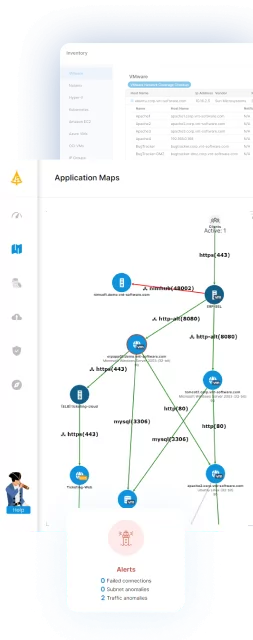What Is IT Operations Management (ITOM) Software?
ITOM (IT Operations Management) software covers a suite of tools designed to monitor, manage, and optimize an organization’s IT infrastructure and services. It aims to ensure the smooth, efficient, and reliable operation of IT systems, including networks, servers, applications, and data centers. ITOM software helps organizations achieve this by providing visibility into real-time operations, automating routine tasks, and enabling faster incident response.
Modern ITOM software addresses the complex demands of both on-premises and hybrid cloud environments. It combines multiple capabilities—including asset tracking, event management, and automation—into unified platforms.
Table of Contents
ToggleKey functions of ITOM software include:
- Monitoring: ITOM software continuously monitors various IT components (networks, servers, applications, etc.) to identify performance issues, potential bottlenecks, and security vulnerabilities.
- Management: It helps manage the configuration, provisioning, and maintenance of IT resources, ensuring they are properly configured and operating optimally.
- Automation: ITOM tools automate routine tasks like patching, resource allocation, and incident response, freeing up IT staff for more strategic initiatives.
- Incident response: When issues arise, ITOM software helps teams quickly identify the root cause and resolve incidents, minimizing downtime and business disruption.
- Performance management: ITOM tools track key performance indicators (KPIs) and provide insights into the performance of IT services, allowing for proactive optimization.
- Service and dependency mapping: ITOM identifies how IT components and services are interconnected and creates visual representations of relationships between them.
- Security and compliance management: It provides tools for monitoring configurations, detecting vulnerabilities, and automating compliance checks to maintain audit readiness.
Benefits of Using ITOM Software
ITOM software offers several key advantages that help organizations maintain efficient, secure, and high-performing IT environments. By centralizing and automating various IT operations, ITOM tools reduce complexity and improve operational effectiveness.
Key benefits include:
- Improved efficiency: Automates routine tasks, freeing up IT teams to focus on more strategic initiatives.
- Enhanced visibility: Provides real-time insights into system performance, enabling quicker issue detection and resolution.
- Reduced downtime: Helps prevent service disruptions by proactively identifying and addressing potential problems before they affect users.
- Cost optimization: Simplifies operations and maximizes the use of IT assets, leading to better resource allocation and cost savings.
- Faster incident response: Speeds up issue resolution by prioritizing incidents and automating responses, improving mean time to resolution (MTTR).
- Better compliance and security: Ensures adherence to security policies and regulatory standards, reducing risks associated with breaches and non-compliance.
- Scalability: Supports growing IT environments by automating tasks and processes, reducing the need for additional staff as the infrastructure expands.
- Agility: Improves an organization’s ability to respond to changes and innovations in a fast-paced business environment.
Related content: Read our guide to ITOM visibility
Key Components of ITOM Software
Monitoring and Observability
Monitoring and observability features in ITOM software provide insight into application and infrastructure performance by continuously collecting and analyzing operational data. Monitoring tools track metrics such as CPU usage, network throughput, application latency, and uptime, flagging anomalies or degradations in real time.
Observability extends beyond traditional monitoring by offering deeper context into system behaviors through logs, traces, and metrics correlation. This holistic view allows IT teams to understand the root causes of incidents faster and proactively address issues before they affect end users.
IT Asset Management (ITAM)
IT Asset Management (ITAM) is a fundamental component of ITOM software, focused on tracking and managing the lifecycle of IT assets, including hardware, software, and virtual resources. ITAM helps organizations keep accurate records of asset inventories, locations, ownership, and configurations.
By enabling automated discovery and monitoring of assets, ITAM reduces manual effort and eliminates discrepancies in asset data. ITAM also aids in risk reduction, helping organizations respond faster to recalls, end-of-life notices, or vulnerabilities associated with particular assets.
Configuration Management Databases (CMDB)
A Configuration Management Database (CMDB) is a centralized repository within ITOM software for storing information about IT assets, their configurations, and relationships. The CMDB enables organizations to understand dependencies between components—such as applications, servers, databases, and network devices—providing a single source of truth for change management and incident response activities.
Maintaining an up-to-date CMDB is critical for impact analysis when planning changes or diagnosing issues. Accurate configuration data supports regulatory compliance, audit readiness, and reduces the likelihood of service disruptions.
Automation and Orchestration
Automation and orchestration capabilities in ITOM software simplify routine IT tasks, such as patch management, software deployment, and infrastructure provisioning. Automation reduces manual intervention, speeds up repetitive workflows, and ensures tasks are performed consistently according to defined policies. This results in reduced operational costs, improved productivity, and the ability to handle growing environments without adding headcount.
Orchestration builds on automation by coordinating multiple automated tasks across systems
and platforms to achieve broader business outcomes. For example, it can automate incident response by triggering diagnostics, escalation, and resolution steps across different tools.
Incident Response and Management
Event and incident management modules enable ITOM software to detect, categorize, and respond to system events or operational anomalies. These systems aggregate alerts from across the IT stack, prioritize incidents based on severity, and enable rapid resolution through predefined playbooks or escalations.
Incident management workflows are often integrated with ticketing and communication systems, ensuring accountability and traceability throughout the resolution process. Automation in event management accelerates root cause analysis and recovery, yielding faster mean time to resolution (MTTR) and minimizing unplanned outages.
Performance Management
Performance management capabilities allow IT teams to track and analyze the health and efficiency of systems and applications. By monitoring KPIs such as response times, throughput, and resource utilization, these tools help maintain service levels and optimize infrastructure performance.
Advanced analytics in performance management provide predictive insights to detect trends and anticipate potential bottlenecks. This enables proactive tuning of systems to avoid performance degradation and ensure consistent user experience.
Service Mapping and Dependency Mapping
Service mapping is the process of visualizing and documenting how IT components interact to deliver business services, while dependency mapping highlights the relationships between infrastructure, applications, and end users. These tools are essential for understanding the impact of changes, troubleshooting issues, and ensuring that critical services remain available.
By identifying dependencies, ITOM platforms help prevent cascading failures and improve root cause analysis during outages. Service and dependency mapping are especially valuable in hybrid and cloud environments where complex, dynamic relationships exist. Accurate mapping supports effective change management, risk assessment, and disaster recovery strategies.
Security and Compliance Management
Security and compliance management functions within ITOM software ensure that IT operations adhere to organizational policies and regulatory standards. These features automate the monitoring of security configurations, detect vulnerabilities, and track compliance status across all managed assets. Integration with SIEM tools and vulnerability scanners further improves threat detection and response capabilities.
By providing real-time alerts and compliance reporting, ITOM software helps organizations quickly address security gaps and maintain audit readiness. Automated remediation workflows limit exposure to breaches, reduce manual compliance checks, and support continuous adherence to industry standards.

Lanir specializes in founding new tech companies for Enterprise Software: Assemble and nurture a great team, Early stage funding to growth late stage, One design partner to hundreds of enterprise customers, MVP to Enterprise grade product, Low level kernel engineering to AI/ML and BigData, One advisory board to a long list of shareholders and board members of the worlds largest VCs
Tips from the Expert
In my experience, here are tips that can help you better leverage ITOM software for maximum impact:
- Build a “service-first” mindset before deploying ITOM: Shift IT operations focus from individual infrastructure components to end-to-end business services. Map critical services upfront so ITOM tools can be aligned to monitor what truly matters to the business.
- Integrate ITOM with DevOps pipelines: Many organizations fail to connect ITOM to CI/CD workflows. By feeding deployment data into ITOM tools, you can proactively correlate releases with incidents and shorten the feedback loop for developers.
- Leverage synthetic monitoring for proactive issue detection: Go beyond passive monitoring by simulating user interactions and transactions. Synthetic monitoring helps surface issues before users encounter them, which is especially vital for customer-facing systems.
- Enrich CMDB data with external threat intelligence: Most CMDBs only show internal configurations. Augment them with feeds on vulnerabilities and exploits from threat intel platforms to prioritize patching and reduce risk exposure.
- Implement event correlation with business impact scoring: Don’t just group alerts; assign business context and impact scores to incidents so response teams can prioritize what matters most for revenue and customer satisfaction.
Notable ITOM Software
1. Faddom
Faddom is an agentless application dependency mapping platform that enhances IT visibility across hybrid environments. By automatically discovering how servers, business applications, and services connect, Faddom helps IT teams maintain accurate configuration records, accelerate incident resolution, and improve the quality of their CMDB and service maps.
Its real-time, visual topology maps eliminate blind spots and reduce the manual effort required to track changes. Faddom supports ITOM workflows by enriching asset management, change management, and operational monitoring with always-updated infrastructure intelligence.
Key features include:
- Automatic service and dependency mapping: Continuously identifies relationships between infrastructure and applications, providing an up-to-date system of record.
- Enhanced CMDB accuracy: Keeps configuration data reliable by feeding real-time insights into your CMDB, minimizing drift and improving impact analysis.
- Change tracking and incident context: Maps changes over time and visualizes dependencies to help teams investigate incidents faster and avoid missteps during maintenance.
- Agentless and fast deployment: Deployed in under 60 minutes with no agents, credentials, or packet inspection. It’s ideal for hybrid and dynamic IT environments.
Book a demo to discover how Faddom supports more resilient and efficient IT operations!
2. ServiceNow
ServiceNow ITOM software provides a solution to optimize and manage complex IT environments, from on-premises data centers to cloud infrastructures. By integrating various tools and technologies, it helps organizations gain visibility into their IT operations, ensuring reliable service delivery.
Key features include:
- AI-driven automation: Leverages generative AI for automated alert triage
- Operations visibility: Provides a view of the entire IT footprint, from on-premises to cloud environments.
- Service mapping: Visualizes the relationships between IT components and business services to understand the impact of changes and troubleshoot more efficiently.
- CMDB integration: Tracks IT service dependencies and relationships within a single system of action for better change management and impact analysis.
- Predictive AIOps: Uses AI to predict potential disruptions and optimize remediation efforts, minimizing user impact.
Source: ServiceNow
3. NinjaOne
NinjaOne IT Operations Management software delivers visibility and control over IT assets, ensuring smooth management of an organization’s IT infrastructure. It enables IT teams to monitor performance, automate maintenance, and ensure high availability across Windows, Mac, Linux, and virtual environments.
Key features include:
- IT visibility: Provides a single-pane-of-glass view for monitoring and managing IT assets, including endpoints, servers, and cloud infrastructure.
- Endpoint monitoring: Supports continuous monitoring of Windows, Mac, and Linux systems.
- Automated patch management: Automatically deploys OS and third-party application patches to maintain security and system integrity.
- Endpoint security tools: Centralized antivirus deployment, scanning, and automated backup to protect against threats like ransomware and accidental data loss.
- Automation: Automates routine maintenance tasks, problem identification, and remediation.
Source: NinjaOne
4. Ivanti
Ivanti IT Operations Management (ITOM) software delivers visibility and control over an organization’s IT infrastructure, enabling issue resolution, efficient resource utilization, and improved business performance. Its automation capabilities allow IT teams to simplify processes, optimize service delivery, and improve security.
Key features include:
- Monitoring and visibility: Provides continuous monitoring of IT infrastructure components, including servers, applications, networks, and storage.
- IT service management automation: Automates workflows and integrates with external systems, eliminating manual processes.
- Configuration management: Automatically manages IT infrastructure components such as updates, patching, and compliance monitoring.
- Automation and orchestration: Automates resource provisioning, application scaling, patching, and security measures to reduce manual effort.
- Analytics and reporting: Leverages predictive analytics, machine learning, and anomaly detection to provide insights into system performance and trends.
Source: Ivanti
5. SolarWinds
SolarWinds IT Operations Management (ITOM) software simplifies IT management tasks by providing a unified platform that offers visibility across the IT environment. Its portfolio of connected tools provides a solution to ensure optimal performance, availability, and security, helping organizations maintain secure IT operations.
Key features include:
- Unified IT visibility: Provides visibility across on-premises, hybrid, and multi-cloud IT environments.
- Application monitoring: Monitors the health and performance of commercial, SaaS-delivered, and custom web applications.
- Database optimization: Enhances the performance of databases with monitoring, alerting, and performance tuning capabilities.
- Security solutions: Correlates logs and events, tracks server changes, and automates software patching to improve security posture and reduce vulnerabilities.
- IT service management: Simplifies the management of people, processes, and technology with ITSM solutions.
Source: SolarWinds
6. Freshservice
Freshservice IT Operations Management (ITOM) software uses AI to optimize service uptime, improve business continuity, and improve incident response times. By consolidating alerts, automating workflows, and providing service health monitoring, it enables IT teams to respond faster to service disruptions.
Key features include:
- Alert management: Consolidates and standardizes all alerts into a single view, reducing noise and allowing teams to focus on solving issues rather than sorting through data.
- On-call management: Automates 24/7 agent coverage with escalations through MS Teams, Slack, WhatsApp, SMS, phone, and email, enabling efficient incident resolution and collaboration.
- Major incident management: Simplifies major incident response by providing context, centralized data, and AI-powered workflows to address high-severity issues.
- Service health monitoring: Offers a view of service performance and incident impact, helping teams monitor and prioritize incidents based on user impact and service-level agreement (SLA) goals.
- Status page: Informs end users about planned or unplanned downtime through a customizable status page, with embeddable badges and widgets for integration across customer-facing websites and support portals.
Source: Freshworks
7. OpsRamp
HPE OpsRamp provides autonomous IT operations for hybrid environments, helping organizations minimize downtime and improve the resilience of their IT infrastructure. It improves service delivery and operational efficiency by offering visibility into IT assets across data centers, clouds, and edge environments.
Key features include:
- Unified observability: Provides visibility into the health and performance of servers, applications, networks, AI workloads, and virtual resources across hybrid environments.
- AI-powered analytics: Uses AI to detect anomalies and resolve issues faster.
- Automation: Automates incident resolution, monitoring template application, patching, and compliance management.
- Integration with IT systems: Integrates performance and health data from systems across cloud, data center, and edge environments.
- Bi-directional ITSM integrations: improves collaboration and responsiveness by integrating with IT service management (ITSM) tools.
Source: HPE
Conclusion
ITOM software plays a crucial role in modern IT environments, enabling organizations to manage their technology infrastructure effectively, optimize performance, and deliver reliable services to their users. By integrating monitoring, automation, and management capabilities, ITOM software empowers organizations to simplify operations, enhance resilience, and adapt to the demands of dynamic IT environments.







